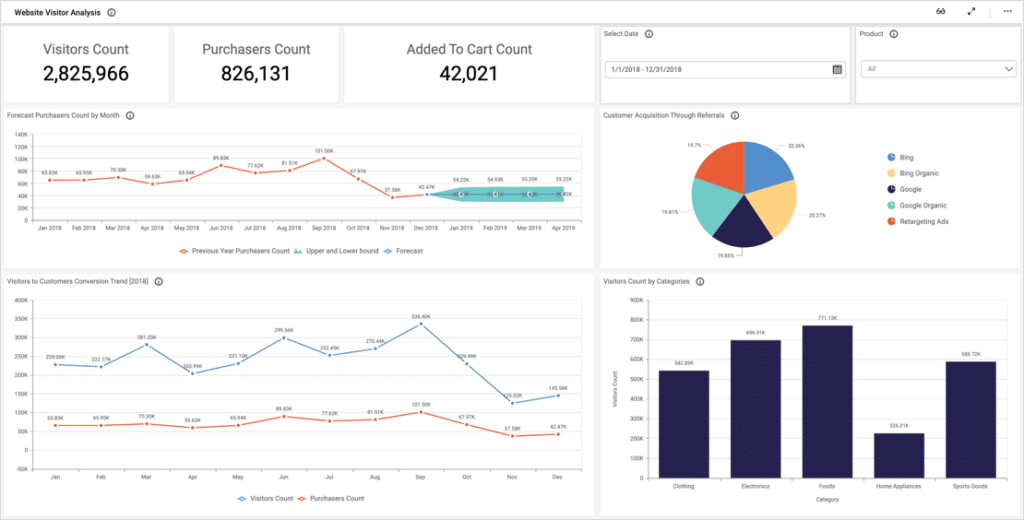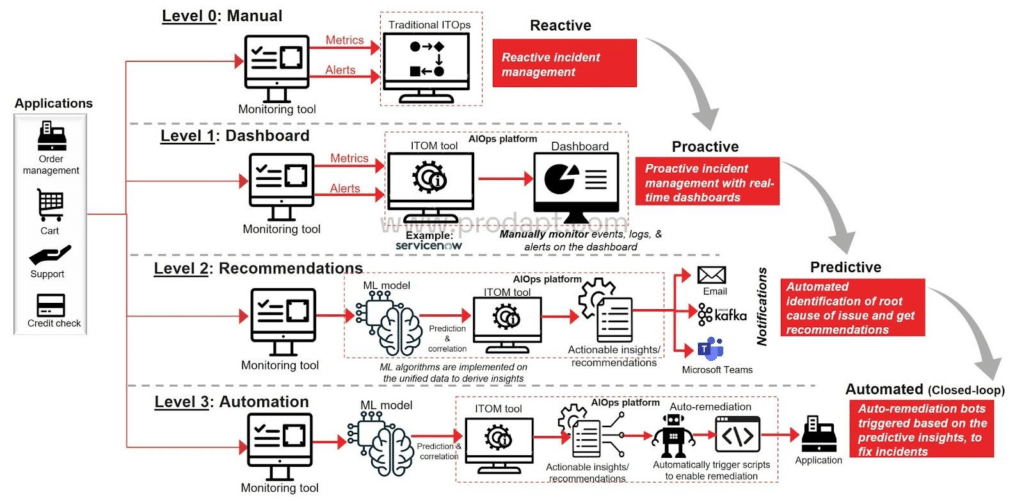How Is AIOps Transforming the Future of IT Operations?
In today’s digital landscape, effectively managing IT operations has become increasingly challenging for organizations. IT teams face significant challenges in effectively monitoring, analyzing, and responding to incidents because of the complexity of IT environments and the exponential growth of generated data.
AIOps, or artificial intelligence for IT operations, however, stands out as a game-changing solution. For the purpose of improving IT operations and enabling proactive decision-making, AIOps combines big data analytics with artificial intelligence (AI) and machine learning (ML) techniques.
Fundamentally, AIOps automate and enhance many elements of IT operations using machine learning (ML) and artificial intelligence (AI) technologies. AIOps delivers real-time insights from a range of sources, enabling predictive analytics, large-scale data analysis, and proactive decision-making.
It acts as a multiplier for IT teams, improving their capabilities and encouraging increases in productivity across the board.
10 Ways in Which AIOps is Transforming the Future of IT Operations
1. It Dismantles Data Silos
One of the major issues in IT operations is dealing with data silos. It is difficult to provide a complete view of the IT environment since data is scattered among different systems, programs, and tools.
AIOps break down these data silos by combining and correlating data from diverse sources. By collecting and analyzing logs and metrics in real-time, IT teams can proactively identify issues, troubleshoot problems, and detect anomalies promptly. This level of real-time monitoring helps break down silos by providing a unified view of the system’s health and performance.
Because of this, businesses are able to have a unified picture of their IT operations, which makes effective troubleshooting, capacity planning, and performance optimization much simpler.
2. Cloud-Native Architecture
Nowadays, most businesses are moving to cloud-native designs as cloud computing appears to be becoming more and more popular. AIOps aid in smooth integration with cloud platforms and make use of their capabilities to enable full monitoring, analysis, and control of cloud-based resources.
This makes it possible for IT teams to keep an eye on and improve the functionality of apps and services that are running in the cloud, resulting in a smoother and more effective operation.
3. AIOps Eliminate IT Operational Noise
In typical IT operations, managing alerts takes up a lot of time, even when many of them turn out to be false positives or inconsequential occurrences. AIOps assist in overcoming this challenge by prioritizing and filtering alerts based on their relevance and criticality.
These AI and ML techniques can help AIOps better find and emphasize important alarms. Consequently, less noise will be produced, enabling IT specialists to focus on the most pressing issues.
4. Driving Digital Reinvention
AIOps play a crucial role in digital transformation by providing real-time insights into user behavior, application performance, and operational effectiveness. By identifying trends, patterns, and anomalies, AI-driven analytics assist businesses in making data-driven decisions and progressing their digital transformation projects.
For example, let’s take a retail business that has chosen to undergo a digital transformation. They may use AIOps to help them analyze aspects like user behavior, application performance, and operational efficiency in real-time. This will allow them to notice trends, detect outliers, and make statistic-driven decisions to help them stay competitive in the digital marketplace.
5. Improving Customer Satisfaction
For every business to succeed, customers must have a good experience. By actively recognizing and fixing issues that could impair overall performance and seamless service, AIOps contribute to the delivery of a better customer experience.
AIOps dramatically improve customer happiness by reducing service interruptions, speeding up response times, and proactively eliminating potential bottlenecks.
6. Optimizing DevOps Decision-Making
AIOps proves to be a valuable asset in optimizing DevOps practices by automating laborious operations and providing valuable insights. By analyzing data from different stages of the software development lifecycle, AIOps facilitates informed decision-making and highlights areas for improvement and resource optimization.
Consider an IT corporation implementing DevOps practices. They use AIOps to automate repetitive processes like performance monitoring and configuration management.
AIOps supports making educated decisions, finding bottlenecks, and allocating resources effectively using data analysis across the software development lifecycle, leading to quicker deployments and better software quality.
7. Effective Monitoring and Analytics
AIOps leverages machine learning algorithms and advanced analytics to automatically identify patterns, abnormalities, and correlations within the vast amount of data produced by IT systems. This provides IT teams with insightful information about system performance, security risks, and operational effectiveness in a rapid and efficient manner.
Early detection of problems allows organizations to take preventive action, avoiding costly downtime and maintaining operational efficiency. With some monitoring tools that have integrations with SLack, Microsoft teams, etc it is possible to get alerts directly.
8. Service Degradation Detection
AIOps greatly improves the detection of service degradation by continuously monitoring metrics and performance indicators. By identifying early warning signs and anomalies, AIOps help businesses minimize the impact on customers and prevent service interruptions, ensuring the highest level of service.
For instance, take into account a large e-commerce platform that utilizes numerous interconnected services. AIOps continuously monitors crucial performance indicators like transaction success rate, server health, and website response time.
AIOps instantly notifies the operations team if response time or transaction success suddenly changes. They can immediately look into the problem and provide a solution, protecting customers and avoiding service interruptions.
9. Strengthening Incident Management Capacities
Similarly, prompt issue resolution and downtime minimization depend on an effective incident management system. By automating incident detection, analysis, and resolution, AIOps improve incident management capabilities.
Machine learning algorithms are able to recognize similar incidents and recommend suitable fixes by using historical data. As a result, the mean time to repair (MTTR) is decreased, and the incident resolution process is sped up.
Additionally, AIOps make it possible to link incidents to their underlying causes, assisting organizations in putting long-term fixes into place and avoiding recurrent problems.
10. Boosting the Financial Ecosystem
Cost savings and better financial management are just two of the prominent business advantages of AIOps. By maximizing resource utilization, identifying inefficiencies, and foreseeing capacity demands, AIOps help organizations lower the cost of managing their IT operations.
The disclosure of resource use patterns and trends ensures it also enables more precise financial planning and budgeting. Better financial management enables organizations to deploy resources more strategically, maximize investments, and encourage overall corporate expansion.
Implementing AIOps in IT Operations Brings Several Tangible Business Benefits
- Collaboration: AIOps encourage cooperation among various teams within an organization, including those responsible for IT operations, development, and business stakeholders. AIOps promote cross-functional cooperation and alignment towards shared objectives by offering a unified view of IT operations and useful insights.
- Improved Business ROI and IT Productivity: By streamlining IT operations, decreasing downtime, and increasing overall efficiency, AIOps increase corporate return on investment (ROI). It automates routine activities, freeing up IT resources to concentrate on innovative and strategic projects.
- Digital Transformation Success: Successful projects for digital transformation depend on AIOps. It offers the skills and talents required to keep track of and manage complicated IT systems, adjust to new technological developments, and give clients flawless digital experiences.
- Improved Performance Monitoring and Service Delivery: Real-time visibility into an organization’s IT infrastructure and application performance is made possible via AIOps. It supports the monitoring of important performance metrics, the detection of anomalies, and optimum service delivery.
Summary
By using AI and ML to automate and improve numerous elements of IT administration, AIOps are altering the future of IT operations. It removes operational noise, improves customer experience, supports DevOps decision-making, overcomes monitoring and analytics issues, and promotes the success of the digital transformation.
By enhancing performance monitoring, incident management, financial management, and cooperation, AIOps helps organizations become more effective and agile.
Adopting AIOps is crucial for businesses looking to prosper in the digital era because of the exponential expansion of data and the rising complexity of IT environments. Organizations can revolutionize their IT operations, foster innovation, and stay one step ahead of the competition by leveraging the power of AI.






























